Understanding some of the basics is fundamental to understanding all the latest trends and most exciting technologies in boat design.
For all their variations and quirks, boat hulls come in only three forms. Here’s a look at the various types, along with a closer look at the most misunderstood—the semi displacement hull.
Table of Contents
- Three Types of Boat Hulls
- Identifying Boat Hull Type
- Boating Always Involves Compromise and Balance
- Hull Shape FAQs
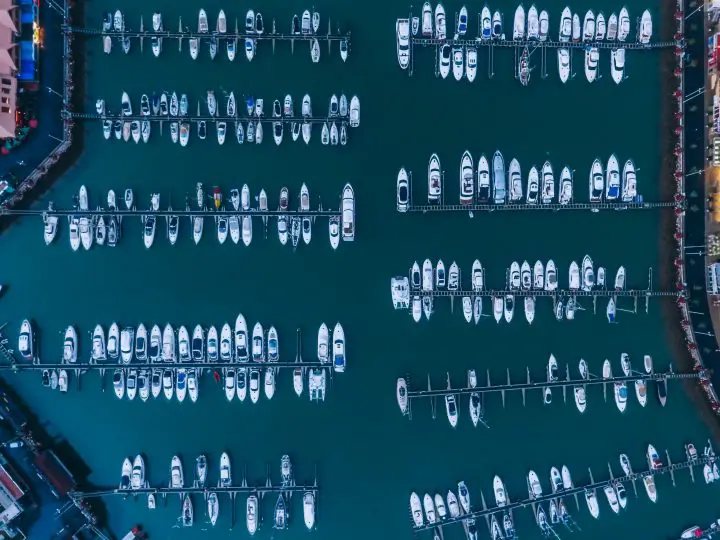
Three Types of Boat Hulls
Even though there seem to be thousands of different types of boats, there are actually only three hull forms in the world. Sure, designers are constantly tinkering with little things to make them faster or more efficient. But boats will always have either a displacement, planing, or semi displacement hull.
Displacement Hull
The first type of boat is the oldest – the trusty old full displacement hull. Displacement hulls have been around forever – dugout canoes, cargo ships, cruise liners, and sailboats are all displacement hulls.
What common things tie these seemingly different boats and ships together? For one, their design stability and the buoyancy that keeps them afloat comes from the water that their hulls displace. Hence the name – displacement hull.
A full displacement boat has a top speed limited by its waterline length. The longer the boat, the faster its theoretical hull speed is.
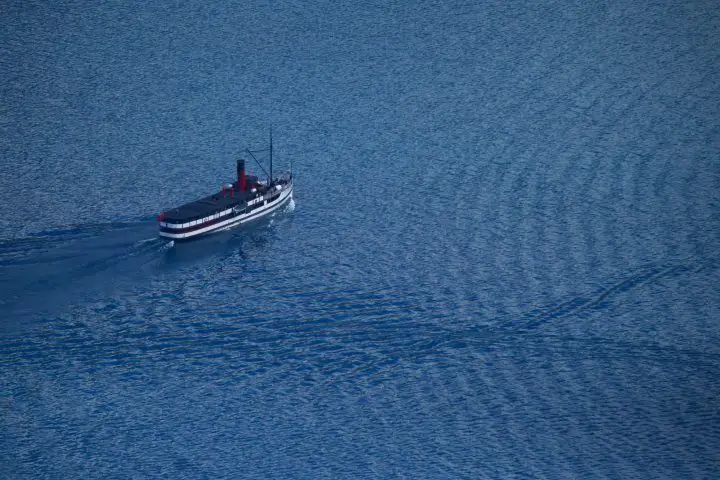
What is Water Displacement?
When discussing boat design, it is impossible not to talk about the elephant in the room—Archimedes. Ok, he wasn’t an elephant. He was a Greek mathematician and physicist—but you get the idea.
Archimedes was one of the first to apply math to the physical world, and he came up with the law of buoyancy. Archimedes Principle states that the upward force on an object immersed in a fluid (buoyancy) is equal to the weight of the fluid that the object displaces.
For boats, this simply means that so long as the boat displaces an amount of water that weighs more than the boat, the boat will float.
So what is a displacement hull? It is one that derives its buoyancy from the weight of the water it displaces. If weight is added to the boat, it sinks lower and displaces more water.
The key here is that this is the only force that keeps the boat afloat.
Planing Hulls
On the other end of the spectrum, we have the modern planing hull boat. If a boat goes fast, it must have a planing hull. Envision speed boats, power racing boats, most fishing boats like bass boats or center consoles, and things like jet skis or skiffs.
When these boats are not moving, they act as displacement hulls. Their shape displaces enough water to keep them afloat. But once they start building up speed, the water passing over the bottom of their hulls creates lift.
That is the critical difference. At some point, the hull of a planing boat gets on plane—it lifts out of the water. It is no longer displacing enough water to keep it afloat. Instead, a dynamic lifting force is being created by the water flowing under the hull. Once that force diminishes (as the boat slows down), the boat will start displacing water again and will once more become a displacement hull boat.
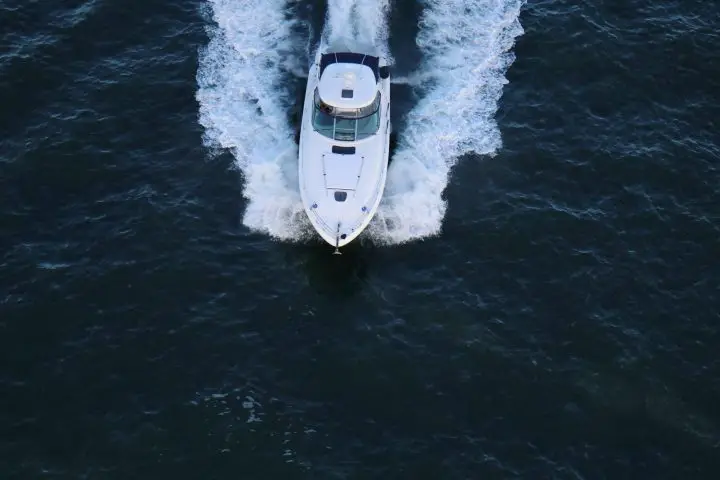
Displacement Hull vs Planing Hull
There are a lot of differences between these two hull designs. They look different, and they function differently.
Planing hulls are built for speed, and many compromises are made in the design to accommodate this need. It takes a lot of power to get any boat on plane. Engines must be big and powerful, which means they’re also thirsty. That means they’ll need large fuel tanks.
In all other aspects of the boat, weight must be limited. A heavier boat will require more power to lift onto plane, so overloading a planing hull means it might not be able to get up to speed. Planing designs favor lighter materials and thinner construction to keep weight down—all benefiting performance.
On the other end of the spectrum, displacement hulls are all about everything other than speed. By committing to a displacement hull, the builder says, “speed is not the priority here.” So what is the advantage, if any, to an old-school displacement hull?
First and foremost, displacement hulls are efficient. It takes very little power to get a displacement hull to speed, which means less fuel and smaller engines need to be carried.
There are also fewer limitations on how much weight a displacement hull can carry. A displacement hull will use about the same amount of power, whether lightly loaded or heavily loaded. As a result, displacement hulls are the types of design used for things like cargo ships and supertankers.
Even if you aren’t hauling cargo, all of the room that a wide displacement hull provides makes for excellent living accommodations. On a cruising boat, this type of design usually gives you the most space for staterooms, galleys, heads, and salons – in other words, they are comfortable to live on.
The contrast is the planing hull, which often sacrifices creature comforts due to the hull design’s shape and depth constraints. Without adding enormous superstructures topside, there just isn’t much room inside a planing hull for living accommodations.
Finally, displacement hulls can be designed to be highly stable and self-righting. Sailboats, for example, with their deep keels and heavy ballast, are designed to be stable in all conditions. For this reason, displacement hulls are considered to be the most seaworthy design.
Ride Quality and Comfort Compared
When it comes to cruising boats, displacement hulls often get a bad rap for their ride quality. While they are safe and stable, the ride tends to be rollier than any other type of vessel. Their rounded hulls and low center of gravity allow them to slip through the waves, but they feel each and everyone nonetheless.
Most cruising boats add some form of stability to reduce roll in a seaway. Sailboats use their sails, the pressure on which keeps the boat heeled over and resists the motion of the waves. Slow trawlers tended to have small stability sails, which did the same thing. Modern boats sometimes include stabilizers that keep them level and resist the motion of the seaway.
Rolling is less of a factor on planing boats since the boat rides above the waves. But the speed at which the boat moves creates another factor – a pounding as the hull goes from wave to wave. Depending on the vessel, this can be more tiresome and exhausting for the crew than the ride on a displacement vessel.
Of course, there’s also a limit to how much the boat can take. The stability and safety of a planing boat require the operator to pick and choose how and when they want to tackle each wave. This means the skipper’s job is never-ending in rough seas.
At the helm of a displacement boat, the skipper might set the sailboat autopilot to a heading and take their lumps. But at the helm of a boat on plane, the helmsperson is more likely to be actively making adjustments to the boat’s course to find the smoothest ride and prevent jaw-clenching bounces.
Semi Displacement Hull
So, what is the third type of boat then? A semi displacement hull could also be called a semi planing hull. This type of boat gets its buoyancy and stability from a combination of the two factors listed above – buoyancy and dynamic lifting forces on the hull.
Like all boats, the semi displacement hull design starts out as a displacement hull when sitting in the water. Its hull design makes a dynamic lifting force as it accelerates because of the water flowing around it – much like a planing hull does. The difference is that a semi displacement hull will never get entirely on plane. Its stern will always sit low, and a portion of the force floating the hull will always come from displaced water.
There are fewer examples of semi displacement hulls because they have limited commercial use. However, the hull design is well known from the Maine lobster boat, which handles offshore seas and conditions well while traveling quickly out of the harbor. A variant of this design used on cruising boats is the Downeast.
Semi displacement designs are also common on modern “fast trawlers,” as well as on offshore deep-sea fishing boats like those made by Hatteras and Viking. Several brands of well-known motor yachts also use semi displacement designs to keep their speeds up while offering excellent living space.
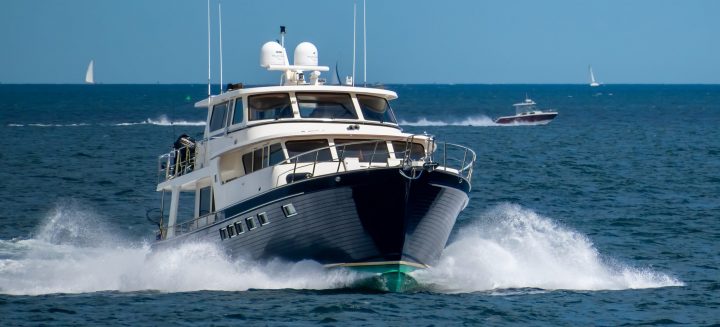
Semi Displacement Boat Performance
That means that semi displacement hulls are not as fast as planing hulls but faster than displacement-only hulls. For a cruising boat, this is perfect because it provides a skipper with options—the option to go slow and safe fuel or the option to put the pedal to the metal and get there a little faster.
Like their speed, they find a compromise in many aspects of their use and form.
For example, their hulls are generally shaped to resemble a slightly sleeker displacement hull. That’s good news for a cruising or liveaboard boat because it means lots of space for storage and living accommodations.
Offshore Ride Quality in a Semi Displacement Hull Boat
The design also has enormous implications for ride quality because the semi displacement boat does not inherit either of the nasty tendencies of the other two. It is stable and steadfast like the displacement hull, but it has enough speed to power through the chop and roll that might make the slower boat wallow.
Likewise, it does not have the same lift on the hull as the planing hull does, so it does not come to the same jarring halt as planing hulls do in big chop. Instead, the boat plows the water out of its way, pushing the waves ahead and forging its own path.
The result is a smooth ride in many different conditions. A semi displacement design is less likely to be rolled but a seaway, and it’s less likely to experience a stop-and-start jerky ride than a planing hull might. This type of boat is great in rough weather and experiences the least wave motion of any design, so long as conditions allow for the speed to be kept up. At displacement speeds, it is less stable than a full displacement boat.
Identifying Boat Hull Type
Have you ever wondered how you would know what sort of hull a boat has? There are a few ways to tell.
If you’re lucky enough to see a boat in a boatyard, you analyze the shape of its underwater features.
- Displacement hulls often have round sides and round bottoms. Their transoms are more likely to be curved or rounded, as well. Displacement hulls tend to be very deep.
- Planing hulls have flat or deep v shaped bottoms with hard chines on the sides to create lift. They often also have strakes–vertical surfaces running fore and aft–that help deflect waterflow and make lift.
- Semi displacement hulls tend to look like displacement hulls in the front, with tall, deep bows, and planing hulls in the back, with flat transoms and a flat aft hull underwater.
If you’re on the water, a great way to tell is by looking at the speed a boat moves and the wake it makes.
- Displacement hull boats and ships move a slow speeds and make very little wake. There is seldom much whitewater in the wake and only a small bow wave that pushes water out of the way.
- A planing hull also makes very little wake, but it is white water pushed out of the way by the hull and powerful propeller.
- A semi displacement hull makes an enormous wake when at cruising speed.
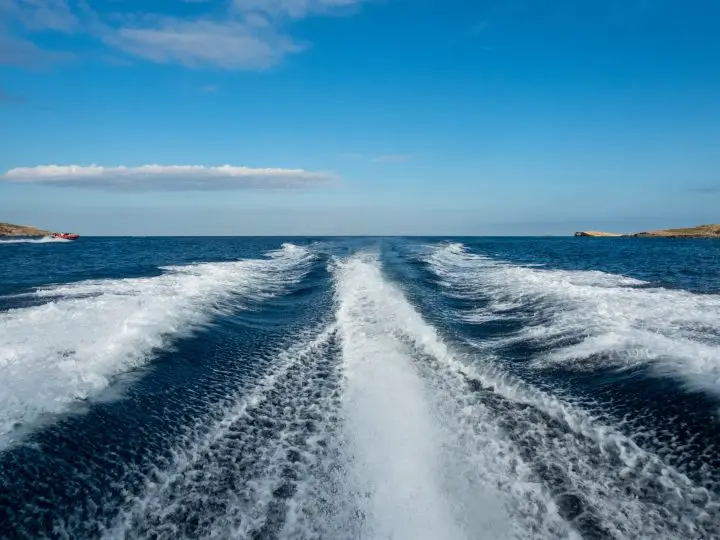
Boating Always Involves Compromise and Balance
Consider this as you evaluate the various boat hull designs – there is no perfect boat.
There isn’t even a perfect boat for a particular boater. All boats represent some form of compromise. Perhaps even more surprising is how we grow and change as boaters. The more years that go by, the more you may find yourself appreciating boat designs that once might have turned you off.
As much as we romanticize them, boats are equipment built for a purpose. As your purpose and use of boats change, so will the sorts of boats that interest you.
Hull Shape FAQs
What is a semi displacement hull?
A semi displacement hull can go faster than a displacement hull, but not as fast as a planning hull. In more technical terms, its buoyance and stability while cruising come from both buoyancy provided by the hull and dynamic lifting forces created by the hull moving through the water.
What type of hull is best for rough water?
Much depends on the boat in question and the preferences of the skipper. The safest boat will likely be the slow displacement hull boat, designed to plow through seas and chop comfortably. A well-designed and well-ballasted displacement hull is exceptionally stable and is self-righting. The limitation of these boats is that they are slow – they are limited to their hull speed.
Skippers looking for a faster ride but still smooth and comfortable may opt for a semi displacement hull. These boats are not efficient performers in the miles per gallon category, but good ones provide an exceptionally smooth ride in rough chop. The extra speed can also help a skipper time the seas for the best ride and get you out of the soup faster.
What is the most efficient hull shape?
In terms of fuel efficiency, the most efficient hull shape is the displacement hull. This type of boat is limited to its theoretical hull speed. They sit low in the water and push the water out of their way. Speeds less than their hull speed require very little power—and, therefore, very little fuel.
